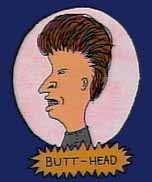Big
Ugly
Truly
Terrible
Hideous
Extremely
Asinine
Discussion
("Butthead Seminar")
 FALL 1999 BUTTHEAD ACTIVITY
FALL 1999 BUTTHEAD ACTIVITY
During Fall 1999, the BUTTHEAD seminar turned its attention to radiation
theory. Drs. Shanks and Luttermoser gave presentations as follows:
- Electrodynamics: A Case Study in Field Theory
Niall Shanks
- Introduction to Field Theory (Classical Electrodynamics)
- Boundary Conditions and the Old Quantum Theory
- Quantum Electrodynamics and Fock Space Formalism
- The Many-Body Problem in Quantum Electrodynamics
- The Quantum Vacuum
- Radiative Transfer
Don Luttermoser
We met at 2:00 on Fridays in room 265 of Brown Hall.
SPRING 1999 BUTTHEAD ACTIVITY
The Institute continued the series of lectures started during the previous
semester. Dr. Bob Gardner gave a number of talks on
general relativity (originally planned for the previous semester),
in particular he "derived" (a term to be taken loosly!)
Einstein's field equations. He then solve the field equations in the
special case of a spherically symmetric mass and used this solution to
demonstrate the precession of orbits and the bending of light.
For additional information on these topics see Dr. Gardner's
Differential Geometry class homepage.
Dr. Don Luttermoser then gave several lectures on the cosmological
implications of general relativity.
We will rapped up this semester with a discussion of the various
philosphical implications of modern cosmological theories (including the
topic of "hubris and cosmologists"). Check out a few of the quotes that we hope to use to initiate our
discussions.
FALL 1998 BUTTHEAD ACTIVITY
The Institute sponsored a series of lectures during Fall 1998
which addressed special and general relativity. We had the following outline:
- The Historical Background Leading Up To The Development of Special
Relativity. Dr. Niall Shanks will present a number of the "ether theories"
popular in the late 1800's.
- Special Relativity. Mr. Brian Heaton will present the mathematical
theory of special relativity including time dilation, length contraction,
spacetime diagrams, Lorentz transformations, and
E=mc2.
- General Relativity. Dr. Bob Gardner gave a number of talks on
curvature and differential geometry which lead into a discussion of
Einstein's field equations. Dr. Gardner completed this series of talks
during Spring 1999.
The talks were held in Room 265 of Brown Hall on Fridays at 3:00.
The "brown bag" lunch sessions started during the Summer, briefly
continued during the Fall and were held in the Physics Department's
Computer Lab on
Thursday's at 11:30. For additional information on this program,
contact Mike Castelaz.
SUMMER 1998 BUTTHEAD ACTIVITY
The Institute ran a series of "brown bag" lunch sessions on
Thursdays at 1:00 on the second floor of Brown Hall during Summer
Terms I and II. These lectures involved someone reading a recent
research paper and informally presenting it. A primary target audience was
the three
SARA students in residence at ETSU that summer.
Presentations included:
-
Mike Castelaz: The neutrino mass problem. Presented June 18, 1998.
-
Bob Gardner: Curvature and the Global Topology of the Universe.
Presented June 25, 1998.
- Erica Messer: The Fate of the Universe.
Presented July 2, 1998.
- Rob Piontek: Alpha Magnetic Spectroscopy.
Presented July 9, 1998.
- Diane Lofland: Dark Matter: What it might be and how to detect it!
Presented July 16, 1998.
- Gary Henson: SCUBA. Presented July 23, 1998.
For additional information, contact Mike
Castelaz.
SPRING 1998 BUTTHEAD ACTIVITY
During Spring 1998, there were a number of
presentations
by Robert Gardner on Hilbert space theory and presentations by Niall Shanks
on quantum mechanics. An outline of these talks is given below.
The Fall seminar will deal with relativity and
cosmology. Time and place are to be announced.
Further details of the seminar will appear on this homepage.
An outline of Dr. Gardner's Spring 1998 presentation is as follows:
An Introduction to Vector Spaces, Hilbert Spaces, and Operators
I. Vector Spaces
- 1.1 Introduction
- 1.2 Examples
- 1.3 Dimension
- 1.4 Isomorphism
II. Vector Spaces and Hilbert Spaces
- 2.1 Norms
- 2.2 Completeness
- 2.3 Inner Products
- 2.4 Hilbert Spaces
- 2.4.1 Bases in Hilbert Spaces
- 2.4.2 Seperable Hilbert Spaces
III. Linear Operators on Hilbert Spaces
- 3.1 Linear Operators and Operator Norms
- 3.2 Adjoint and Self-Adjoint Operators
- 3.3 Inverse and Unitary Operators
- 3.4 Eigenvalues and Eigenvectors
APPENDIX A - Unitary Operators
APPENDIX B - Projection Operators
An outline of Dr. Shanks' Srping 1998 presentation is as follows:
Quantum Mechanics
- Classical Probability Theory
- Probability Questions in Classical Mechanics
- Transition from Classical Mechanics to Quantum Mechanics
- (a) The Schroedinger equation.
- (b) Quantum States.
- (c) Observables.
- (d) Probabilites.
- (e) von Neumann axioms.
- The Measurement Problem in Quntum Mechanics
- (a) Radioactive decay.
- (b) The Stern-Gerlach experiment.
- (c) The two-slit experiment.
- (d) Paradoxes.
- (e) Hilbert space analysis of combined systems.
- (f) von Neumann approach to mesurements.
- (g) Jauch's consistency approach to measurements.
- (h) The many-world's approach to measurements.
- (i) The statistical interpretation's approach to measurements.
- The Statistical Interpretation of Quantum Mechanics
- Statistcs and the Hidden Variables Question
- (a) Non-contestual hidden variables question.
- (b) von Neumann's objections to hidden variables theories.
- (c) The Kochen and Specker argument.
- (d) Contextual hidden variables theories.
- (e) The EPR paradox and Bell's Theorem.
- (f) An experimental version of Bell's Theorem.
- (g) The situation at the end of the twentieth century.
Return to the
BUTTHEAD Seminar home page.

